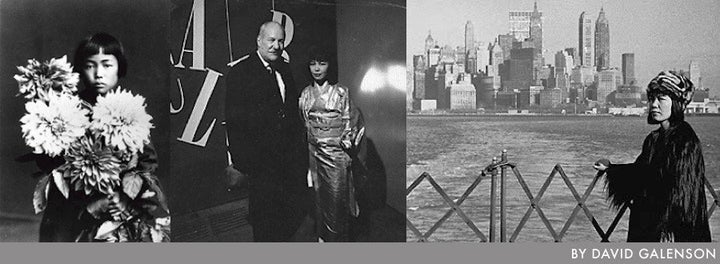
In a contemporary art world filled with the unusual and often the bizarre, one of the very most improbable stories must be that of the Japanese artist Yayoi Kusama. Her remarkable career is currently the subject of a major retrospective exhibition at Paris' Centre Pompidou; when it closes there in January, it will travel to London's Tate Modern for the spring and New York's Whitney Museum for the summer. In a series of large rooms filled with complex and often startling works, the exhibition documents the process by which Kusama overcame formidable obstacles to become one of the most important female artists in the world.
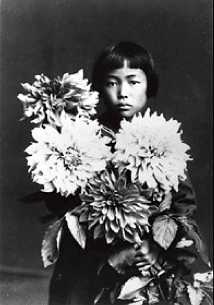
Kusama at age seven, 1935-36. Matsumoto City, Japan. Photograph courtesy of the artist. Museum of Modern Art, New York.
Kusama's autobiography, Infinity Net, published in English translation in conjunction with this exhibition, tells her story in detail. In lucid and unassuming prose, Kusama narrates a career, and a life, that consistently defy belief. She began to experience hallucinations around the time she entered high school. Whenever this happened, she tried to draw what she had seen:
I was in a separate world, and I was drawing in order to document the sights I saw there... Recording them helped to ease the shock and fear of the episodes. That is the origin of my pictures.
And so it remains today, more than six decades later: "My main intention has always been to record the images before they vanish."

Kusama on the Staten Island Ferry, New York. c. 1958. Photograph by Lock Huey. Courtesy of the artist. Museum of Modern Art, New York.
Kusama was ambitious, and overcame the objections of her parents to travel to the United States in 1957, at the age of 28:
If I wanted to develop [as an artist], staying in Japan was out of the question. My parents, the house, the land, the shackles, the conventions, the prejudice... For art like mine... this country was too small, too servile, too feudalistic, and too scornful of women.
She found life in New York difficult: "New York was in every way a fierce and violent place. I found it extremely stressful and was soon mired in neurosis." Yet when the artist Georgia O'Keeffe invited her to live in New Mexico, "I reluctantly declined because I knew that only in New York could I become a star."
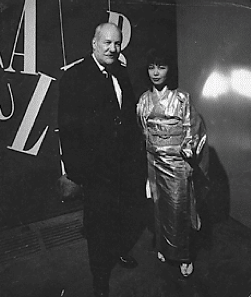
Kusama with Barnett Newman, New York. c. 1961. Photograph courtesy of the artist. Museum of Modern Art, New York.
Damien Hirst recently announced his intention to fill all of Larry Gagosian's galleries with spots, but Kusama was the Priestess of the Polka Dot when Hirst had barely entered grade school. And for Kusama, dots were not merely a commercial strategy. Her first solo show in New York, in 1961, was made up entirely of dots: "My desire was to predict and measure the infinity of the unbounded universe, from my own position in it, with dots--an accumulation of particles forming the negative spaces in the net." These Infinity Net paintings, including one 10-meter-long canvas from 1960, fill a large room at the Pompidou with thousands of small gestural brushstrokes in white paint. Kusama had found a keystone: "I was under the spell of the polka dot nets. Bring on Picasso, bring on Matisse, bring on anybody! I would stand up to them all with a single polka dot!"
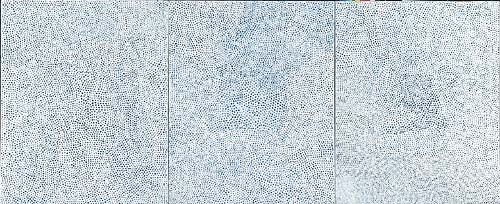
Net Accumulation, Yayoi Kusama, 1958, The National Museum of Art, Osaka.
Kusama has explained that she uses her complexes and fears as subjects. The infinity nets expressed her fear of self-obliteration, as a tiny dot in an infinite universe, and her fear of sex later led her to become a champion of sexual liberation, organizing public happenings with nude participants, covered with polka dots. Her art had an impact on many other artists in the pressure cooker of New York's art world of the 1960s. So for example Andy Warhol saw her Thousand Boats Show-- a rowboat covered with phallic plaster casts, surrounded by 999 photographic images of itself--at a 1963 exhibit, and Kusama remarks that "A few years later, when Andy papered the ceiling and walls at Leo Castelli's gallery with silkscreen posters of a cow's face, it was plainly an appropriation or imitation."

Kusama in front of her 33-foot white Infinity Net painting (no longer extant) at solo exhibition, Stephen Radich Gallery, New York. 1961. Photograph courtesy of the artist. Museum of Modern Art, New York.
Kusama returned to Japan in the mid-1970s, and since 1977 she has voluntarily lived in a Tokyo psychiatric hospital, and worked at a studio she built across the street. She credits her art with literally saving her life:
I fight pain, anxiety, and fear every day, and the only method I have found that relieves my illness is to keep creating art. I followed the thread of art and somehow discovered a path that would allow me to live. If I had not found that path, I am sure I would have committed suicide... I remember the many times I stood beside the tracks of the Chuo Line, waiting for the train and thinking of ending my life. What saved my life was making my way--blindly and gropingly at first--down the path to art.
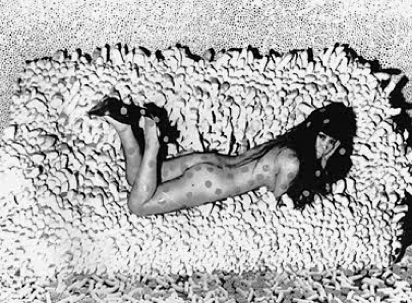
Kusama is an archetypal conceptual artist. Her art is not about appearances, but about her ideas, and obsessions. It is highly personal, and extremely protean in form. The Pompidou exhibition includes paintings, collages, sculptures, installations, videos, and performances. The only visible common link is repetition. Like most conceptual artists, Kusama was most innovative early in her career. The New York art world was a sexist place in the 1950s and '60s, and Kusama, like other women of her cohort, did not get full credit for her achievements. But her early innovativeness is now being recognized. In 2008, a 1959 Infinity Net was auctioned for $5.1 million, at the time a record for a living female artist. And now, past her 80th birthday, she is being honored by an exhibition that allows viewers to see a full survey of the improbable journey of a determined and gifted artist.
Alice in Wonderland performance, Central Park, New York, 11 August, 1968. Photograph courtesy of the artist. Museum of Modern Art, New York.
